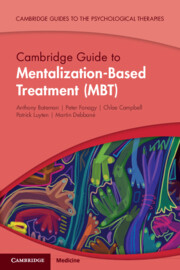Book contents
- Cambridge Guide to Mentalization-Based Treatment (MBT)
- Cambridge Guides to the Psychological Therapies
- Reviews
- Cambridge Guide to Mentalization-Based Treatment (MBT)
- Copyright page
- Contents
- Preface
- A Note from the Series Editor
- Acknowledgments
- Part I Overview of the Model
- Part II The Mentalization-Based Treatment Model in Practice
- Chapter 3 What Is Mentalization-Based Treatment?
- Chapter 4 The Clinical Process of Mentalization-Based Treatment
- Chapter 5 MBT Group (MBT-G)
- Part III Application and Adaptations for Mental Health Presentations
- Part IV Application of Mentalization-Based Treatment in Different Populations and in Different Settings
- Index
- References
Chapter 4 - The Clinical Process of Mentalization-Based Treatment
A Step-by-Step Guide
from Part II - The Mentalization-Based Treatment Model in Practice
Published online by Cambridge University Press: 18 May 2023
- Cambridge Guide to Mentalization-Based Treatment (MBT)
- Cambridge Guides to the Psychological Therapies
- Reviews
- Cambridge Guide to Mentalization-Based Treatment (MBT)
- Copyright page
- Contents
- Preface
- A Note from the Series Editor
- Acknowledgments
- Part I Overview of the Model
- Part II The Mentalization-Based Treatment Model in Practice
- Chapter 3 What Is Mentalization-Based Treatment?
- Chapter 4 The Clinical Process of Mentalization-Based Treatment
- Chapter 5 MBT Group (MBT-G)
- Part III Application and Adaptations for Mental Health Presentations
- Part IV Application of Mentalization-Based Treatment in Different Populations and in Different Settings
- Index
- References
Summary
The case of a patient who is receiving mentalization-based treatment (MBT) is described. All of the stages and interventions of MBT, including interventions for suicidality and violence, are illustrated across the patient’s treatment trajectory. The formulation agreed with the patient is the focus for treatment. Clinical examples are presented to illustrate how to implement the phases of MBT using the formulation. The chapter discusses working with the not-knowing stance, the mentalizing process, non-mentalizing modes, affective narratives, and relational mentalizing. Supervision for the clinician is an essential part of MBT, and this is elaborated particularly in relation to its role in supporting the clinician to manage problematic counter-relational responses to the patient.
Keywords
- Type
- Chapter
- Information
- Cambridge Guide to Mentalization-Based Treatment (MBT) , pp. 52 - 135Publisher: Cambridge University PressPrint publication year: 2023



